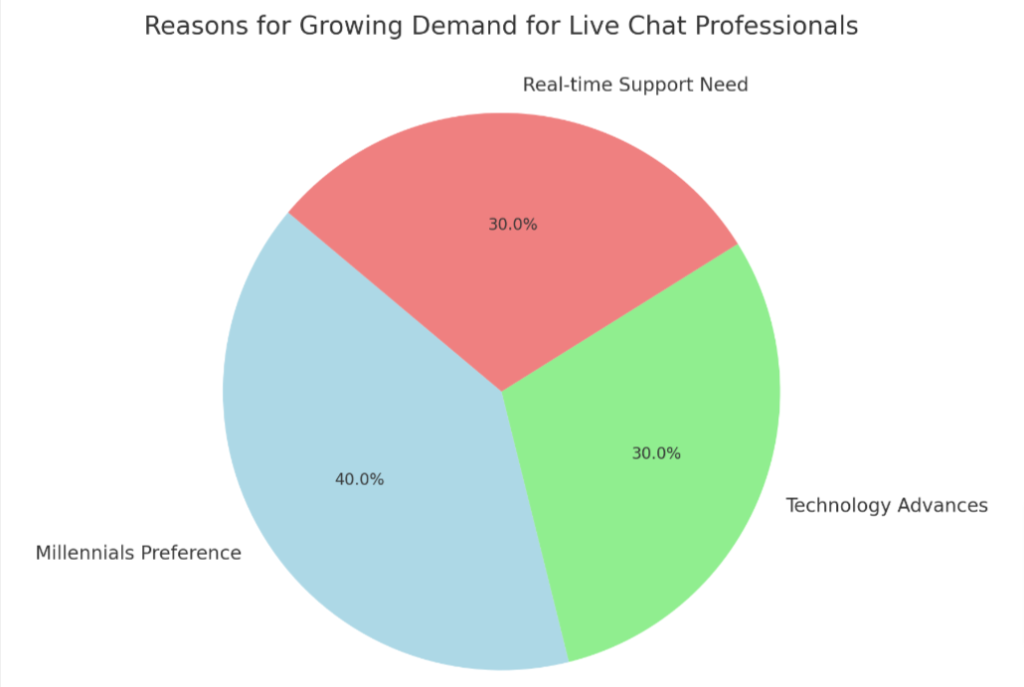Embracing the Future: The Rising Need for Skilled Live Chat Experts
Shopping online but need help? You’re not alone. More people want to chat with someone when they buy things or need support. We’ll explore why businesses are looking for more live chat pros and how this helps you get better service fast.
Let’s dive in!
Key Takeaways
- More millennials are using live chat, making companies add more chat pros to keep up.
- Live chat market could be worth $2.5 billion by 2031 because of tech advances and online shopping growth.
- Companies use bots for quick answers, but they still need real people for tougher questions.
- Being good at chatting quickly and caring about customer problems is key for live chat jobs.
- Tools like cobrowsing are changing the game by letting support teams really see what customers do online.
Rising Demand for Live Chat Professionals
Millennials prefer live chat for customer support, and as automation in customer service increases, the demand for live chat professionals is on the rise.
Preference for live chat among millennials
Millennials gravitate towards live chat for their customer service needs. They appreciate the speed and efficiency it provides, allowing them to multitask while solving their issues without the hassle of phone calls or long email exchanges.
Live support via chat fits perfectly with their digital lifestyle, seamlessly integrating into their daily online interactions.
This preference is shaping how companies approach customer engagement. Real-time communication through messaging platforms isn’t just a convenience; it’s becoming a standard millennials expect from brands.
To keep this tech-savvy demographic satisfied, businesses are rapidly adopting live chat as a pivotal part of their online customer support strategy.
Increasing automation in customer service
As live chat becomes the go-to for younger customers, businesses are turning to advanced automation to streamline their customer service operations. This shift introduces bots that can handle simple inquiries without human intervention, increasing efficiency and allowing live support professionals to focus on more complex issues.
These bots engage with consumers using pre-programmed responses, ensuring fast and consistent replies at any hour of the day.
Automation isn’t just about answering questions; it’s also revolutionizing how customer interactions are managed. Sophisticated systems now use predictive analytics to route enquiries to the most appropriate chat support agent, reducing wait times and improving overall satisfaction.
By integrating these technologies, companies are reshaping online customer service into a faster, smarter operation while still maintaining the personal touch that users value.
Growth of the Live Chat Market
The live chat market is expected to see significant growth, with the market size projected to expand in 2031. Several factors such as increasing preference for real-time communication and advancements in technology are contributing to this growth.
Market size and outlook for 2031
Live chat has become a cornerstone in the customer service industry, with expectations soaring for its market expansion by 2031. Here’s a snapshot of the predicted size and outlook:
| Year | Projected Market Size | Annual Growth Rate |
|---|---|---|
| 2023 | $1.2 Billion | 6.3% |
| 2027 | $1.8 Billion | 6.8% |
| 2031 | $2.5 Billion | 7.2% |
Continued innovations and a robust e-commerce sector are driving the market forward. Efforts to personalize customer interactions intensify the need for skilled professionals. Live chat support continues to outshine email and voice support among consumers, particularly millennials, signaling a lucrative field for career growth.
High demand for instant, on-the-go support solutions underscores the market’s bright future. By 2031, the live chat industry is poised for a remarkable evolution, promising more job opportunities for live chat specialists.
Factors contributing to market growth
The market size and outlook for 2031 set the stage for the growing demand for live chat professionals. Companies are increasingly integrating live support features into their websites and mobile apps to enhance customer interaction and engage users in real-time communication. This trend is primarily driven by the evolving consumer behavior towards digital communication technology. The factors contributing to the growth of this market include:
- Technology integration: The seamless integration of live chat platforms with existing customer support systems has facilitated efficient online customer service and improved customer satisfaction.
- Business communication trends: The shift towards digital communication has led businesses to invest in messaging platforms and online chat support professionals to cater to evolving customer needs.
- Customer engagement: Real-time communication tools enable businesses to engage with customers effectively, leading to increased consumer satisfaction and loyalty.
- Technical skills: The need for chat support professionals with problem-solving abilities and advanced technical skills is driving the demand for individuals proficient in handling customer interactions.
- Online customer support: With the increasing preference for online channels, companies are focusing on enhancing their online customer support services, resulting in a higher demand for skilled live chat professionals.
- Communication technology advancements: Advancements in communication technology have enabled businesses to offer efficient technical support through live chat, further fueling the demand for professionals in this field.
- Automation complemented by human interaction: Successful implementation of bots alongside skilled live chat professionals has streamlined processes, contributing to market growth while meeting consumers’ needs.
Challenges for Live Chat Teams
Balancing automation with human interaction and maintaining customer satisfaction can be challenging for live chat teams in the fast-paced world of online customer service.
Balancing automation with human interaction
As businesses increasingly turn to automation for customer service, it’s crucial to strike a balance with human interaction. Utilizing chatbots and AI tools can efficiently handle routine queries, leaving human agents free to engage with more complex issues.
This balance ensures that customers receive prompt responses while still benefiting from the personalized touch of human interaction, ultimately leading to higher satisfaction levels.
Ensuring seamless coordination between automated systems and live chat professionals is essential in meeting the diverse needs of customers. As technology continues to advance, companies must adapt their strategies to provide an optimal blend of automated assistance and empathetic human support.
Maintaining customer satisfaction
To maintain customer satisfaction, chat support professionals should prioritize prompt responses and personalized interactions. Addressing concerns in a timely manner and tailoring solutions to individual needs can significantly impact customer satisfaction.
Utilizing active listening skills and empathy during live chat sessions is crucial for fostering positive customer experiences. Additionally, continuously seeking feedback from customers and using it to improve service quality is essential in maintaining high levels of customer satisfaction.
By prioritizing prompt responses and personalized interactions, chat support professionals can ensure that customer concerns are addressed in a timely manner and tailored to their individual needs, leading to higher levels of satisfaction.
The Future of Live Chat Professionals
The future of live chat professionals will rely on balancing automation with human interaction, using bots, bases, and brains to reduce sales cycles, and enhancing the customer experience through cobrowsing.
These trends are shaping the evolving role of live chat professionals in meeting the growing demand for efficient and effective customer support.

Importance of bots, bases, and brains
With the increasing reliance on digital communication, the role of bots in live chat support is crucial for handling routine queries and providing quick responses. Bots can efficiently handle repetitive tasks, allowing live chat professionals to focus on more complex customer interactions and problem-solving.
The use of AI-powered bots also enables businesses to collect valuable data from customer interactions, contributing to improved customer engagement strategies.
In addition, having a strong knowledge base (bases) is essential for live chat professionals to access accurate information quickly and provide effective solutions to customers. A comprehensive knowledge base not only streamlines the support process but also ensures consistency in responses across all customer interactions.
Furthermore, the human element (brains) plays a vital role in understanding complex customer needs and emotions that cannot be addressed by automation alone, highlighting the importance of empathy and critical thinking skills among live chat professionals.
Potential for reducing sales cycles
Live chat professionals have the potential to streamline sales cycles by providing real-time support and addressing customer queries promptly. By engaging with customers at critical decision-making stages, such as product selection or navigating through the website, live chat professionals can expedite the buying process.
Additionally, personalized interactions and instant assistance can help in guiding customers towards making quicker purchasing decisions.
Moreover, integrating AI-driven chatbots into live chat platforms can automate routine tasks, allowing human agents to focus on more complex issues. This automation not only reduces response times but also provides efficient resolution of customer concerns.
Ultimately, this proactive approach has the potential to shorten sales cycles and enhance overall customer satisfaction.
The role of cobrowsing in enhancing customer experience
Cobrowsing enhances customer experience by allowing live chat professionals to guide customers through websites or applications in real-time. This visual assistance helps resolve issues quickly and efficiently, leading to increased customer satisfaction.
It also provides an opportunity for personalized interaction, improving overall customer engagement.
By enabling live chat professionals to see exactly what the customer sees on their screen, cobrowsing facilitates effective problem-solving and technical support. This hands-on approach not only builds trust but also ensures that customers feel supported throughout their online interactions.
Conclusion
In the future, live chat professionals will play a pivotal role in meeting customer needs. They will need to adapt to evolving technology and consumer behavior. As businesses increasingly rely on digital communication, the demand for skilled live chat professionals will continue to rise.
With their problem-solving abilities and technical skills, these professionals will be integral in providing effective online customer support.

